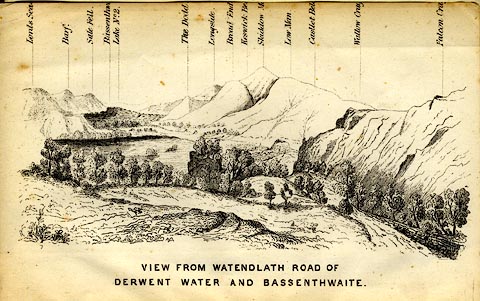 |
 |
   |
|
|
| site name:- |
Skiddaw |
| civil parish:- |
Underskiddaw (formerly Cumberland) |
| county:- |
Cumbria |
| locality type:- |
beacon (??) |
| 1Km square:- |
NY2528 (approx) |
| 10Km square:- |
NY22 |
|
|
| evidence:- |
descriptive text:- West 1778 (11th edn 1821)
|
| source data:- |
Guide book, A Guide to the Lakes, by Thomas West, published by
William Pennington, Kendal, Cumbria once Westmorland, and in
London, 1778 to 1821.
 goto source goto source
Page 125:- "... The garrison at Keswick, would have the care of the beacon on the top of Skiddaw,
the mountain being of the easiest access on that side. ..."
|
|
|
| evidence:- |
perhaps outline view:- Matthew 1866
placename:- Keswick Beacon
|
| source data:- |
Print, engraving, outline view, View from Watendlath Road of Derwent Water and Bassenthwaite,
Cumberland, published by J Richardson, Highgate, Kendal, Westmorland, 1866.
 click to enlarge click to enlarge
MW1E05.jpg
Tipped in before p.1 of The English Lakes, Peaks and Passes, from Kendal to Keswick,
by George King Matthew.
printed at bottom:- "VIEW FROM WATENDLATH ROAD OF / DERWENT WATER AND BASSENTHWAITE."
printed at caption to mountains:- "... Broad End / Keswick Be[ ] / Skiddow M[ ] ..."
item:- Armitt Library : A1168.5
Image © see bottom of page
|
|
|
hearsay:-
|
Skiddaw was one of the northern elements in a system of beacons used to warn of invaders,
and to celebrate important events. The beacons of west Cumberland were on: Black Combe,
Boothill, Moota Hill, Muncaster Fell, Skiddaw, St Bees Head, and Workington Hill.
There are said to have been two beacons on Skiddaw. (This information is not safe.)
|
|
Thomas Babington Macaulay in The Armada:-
|
|
"Til Skiddaw saw the fire that burned on Gaunt's embattled pile
And the red glare on Skiddaw roused the burghers of Carlisle"
|
|
which is slightly wishful thinking, they call it poetic licence, as Skiddaw could
hardly have seen a beacon at Lancaster, and Carlisle would have difficulty with Skiddaw.
|
|
|





 goto source
goto source click to enlarge
click to enlarge